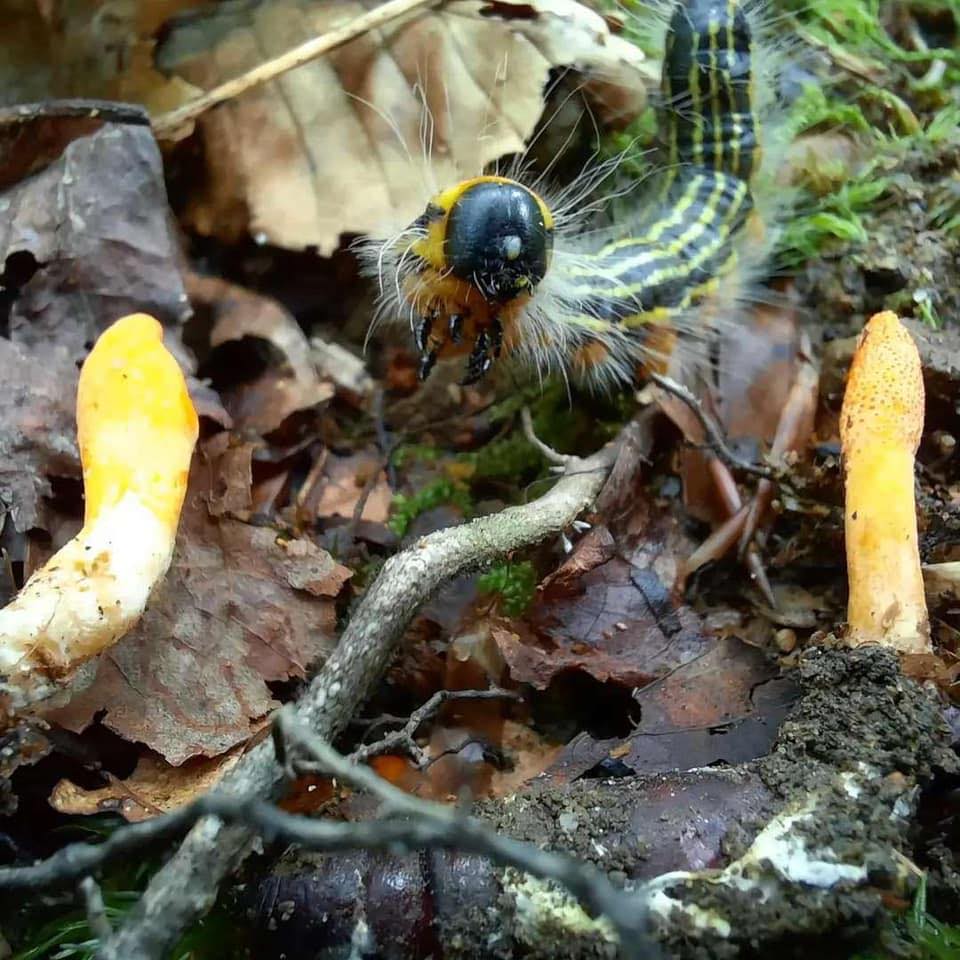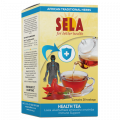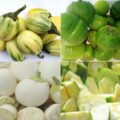With more than 150,000 species of fungi (and perhaps a million or more yet to discover), there’s an ever-growing area of interest in the potential effects fungi have on humans. In fact, fungi have long been used in tinctures, herbal remedies and tonic foods because of their benefits in traditional Chinese medicine and other Eastern medical practices. These are also some of the oldest systems of medicine in the world.
One specific category of fungi called cordyceps has been thrust into the spotlight thanks to its tie-in to HBO’s hit show The Last of Us and its zombie lore. But even before its big Hollywood break, cordyceps has been a popular ingredient in supplements and other products that tout numerous health benefits. Some of these benefits include anti-fatigue, anti-aging and anti-cancer properties that could help improve energy levels, sex drive and even heart health.
Are these products worth your while? Registered dietitian Beth Czerwony, RD, breaks down the science behind cordyceps and whether it’s worth trying any cordyceps supplements.
What is cordyceps?
Cordyceps is a kind of fungi found all over the world. Some of the rarest kinds are at higher altitudes in the Himalayan regions of China, Nepal, Tibet and India. In total, there have been more than 750 species of cordyceps identified. Of those, scientists have identified at least 35 kinds that have had some potential health benefits and medicinal properties.
What makes cordyceps particularly interesting is that they’re parasitic in nature. Each species of cordyceps targets a specific, unique insect. For example, one species of cordyceps can infect a specific type of carpenter ant. But that same species of cordyceps doesn’t have any effect on other kinds of ants even across regions. Other insects that have been targeted by cordyceps include spiders, moths and dragonflies.
Here’s how it works: A cordyceps spore lands on and infects its host. It then starts to spread mycelia (or tendrils) throughout the insect’s body. Those tendrils replace the host’s internal tissues and feed off of its nutrients. Once the insect is fully paralyzed or dead, the cordyceps fungus erupts out of the insect’s body with a fruiting body (the visible reproductive structure of cordyceps). This fruiting body then spreads its spores to other insects of the same species.
The fruiting body is what people seek for its potential health benefits. Traditionally, the fruiting body of cordyceps is ground down and cooked with tea and other herbs. You can eat the fruiting body raw. But it will likely taste better if you cook it in pastas or soups, or even add them as a topping to pizza or flatbreads.
There aren’t any additional benefits to eating raw cordyceps. But if you do intend to eat them raw, you can steep the cordyceps in water for up to 15 minutes before extracting the fruiting body from the insect husk. Or you can eat the insect husk and fruiting body together.
Types of cordyceps
Of all the cordyceps, there are three kinds that you may have heard about:
Ophiocordyceps unilateralis
Until 2007, ophiocordyceps was considered part of the overall cordyceps family. But because of its darker pigmentation, it’s now considered its own separate family of fungi. It still functions much the same way as other cordyceps, but it specifically targets carpenter ants in tropical forests found in Brazil, Australia and Thailand, as well as temperate forests in South Carolina, Florida and Japan.
Ophiocordyceps unilateralis made headlines in 2008 when a clip from BBC’s Planet Earth showed a time-lapse of how this fungus takes over an ant’s body. Ongoing research into the behavior of O. unilateralis suggests the fungus bypasses the ant’s brain completely. Even as the fungi compel the ant to climb to higher ground before sprouting spores to other ants below, the ant’s brain remains intact.
It’s this specific fungus that has gone on to inspire the fictional zombie lore behind The Last of Us video game and TV show. It’s also been a central focus of ongoing research into how cordyceps in general grow and spread.
Cordyceps sinensis
If you’re searching for cordyceps benefits, cordyceps sinensis (also known as Dong Chong Xia Cao, which means “worm in winter, grass in summer”) will likely be at the top of your search list. That’s because this version of cordyceps is the most sought-after kind thanks to its rarity and its long-time use in traditional Chinese medicine.
C. sinensis grows on ghost moth larvae found at high altitudes on the Tibetan Plateau and the Himalayan regions of Bhutan and Nepal. Increased demand has led to an over-collection of the wild fungus, making naturally grown C. sinensis nearly impossible to find. In fact, raw C. sinensis can cost several thousands of dollars. To meet the demand in recent years, companies have started to mass produce cultivated C. sinensis and other alternatives.
Cordyceps militaris
The Cordyceps militaris species of cordyceps is one alternative to C. sinensis that has shown promising results. Unlike C. sinensis, it can be grown in a lab using rice as its base. This has made the production of cordyceps easier, more accessible and inexpensive. Additionally, studies have shown C. militaris has the same composition as C. sinensis, making it a safe alternative for those interested in trying this fungus. But one study in particular suggests you shouldn’t eat C. militaris raw. Instead, you should cook C. militaris before consuming it to avoid potential gastrointestinal (GI) upset or illness.
Cordyceps uses
There are plenty of products that use cordyceps. These products include supplements in the form of capsules, powders, teas and even mushroom coffee. But the tricky part to buying these products — especially supplements — is that you’re never quite sure what you’re getting. The U.S. Food and Drug Administration (FDA) doesn’t regulate supplements, so you never know how much cordyceps a supplement actually contains.
“You may get a very potent dose in one bottle, but then if you were to go and take the same amount from another bottle — even from the same company — you may not get the same amount of cordyceps or even the same benefits,” cautions Czerwony.
Plus, product labels tend to overuse and generalize the term “cordyceps” without specifying which species they’re using. This means you could be getting a kind of cordyceps that hasn’t been shown to have any health benefits.
If you’re seeking a product that uses cordyceps, you should look for labels that specifically use C. sinensis, as that’s the one kind of cordyceps that’s long been associated with traditional Chinese medicine and is perhaps the most reliable. C. militaris is also a good alternative to consider, as long as you cook it first.
“You can safely eat cordyceps, but it tastes better if you cook them or include them in a soup,” says Czerwony. “I wouldn’t rely on capsules or supplements, but if you are adventurous and you’re a foodie and you want to try to eat them or put them in soups, go for it.”
Cordyceps benefits
So, why throw cordyceps in your soup in the first place? A few studies have pointed to some potential health benefits to eating certain kinds of cordyceps, specifically C. sinensis or C. militaris. But it’s important to note that these studies have been small and largely focused on animals in a lab. More research is definitely needed, specifically, studies that measure the health benefits in humans, in order to confirm any of the proposed benefits and how effective they really are.
“It does have value in Eastern medicine and it’s been used for quite a bit of time, but much of that is anecdotal (accounts from people, not research) and there haven’t been enough human studies in Western medicine to determine whether they hold a true benefit,” notes Czerwony.
According to the limited research that’s been done so far, some potential benefits of cordyceps could include:
Anti-inflammatory properties
A review of several research studies suggests cordyceps contain a bioactive component called cordycepin. This can help with inflammation related to asthma, rheumatoid arthritis, Parkinson’s disease, hepatitis and more. In fact, cordycepin has been identified as a potential nutraceutical (a food that contains medicinal benefit). Lab studies suggest cordycepin and cordyceps polysaccharide can have additional positive effects on obesity (a condition often associated with chronic low-grade inflammation). Still, clinical studies are needed to determine if these same effects are present in humans.
“Cordyceps seems like one of those superfoods that can decrease inflammation,” says Czerwony. “When we think about decreasing inflammation, we think of better overall heart health and cholesterol levels, too.”
Increase exercise performance
Reduced inflammation may also help boost exercise performance.
“When you’re exercising, you’re causing inflammation throughout your body,” explains Czerwony. “By decreasing that, you’re going to perform much better.”
One study followed 28 individuals who participated in high-intensity exercise over the course of three weeks while consuming a mushroom blend that contained cordyceps. That study showed significant improvement in VO2 max (a measurement of how much oxygen your body absorbs and uses while working out).
Another study suggests a combination of Rhodiola crenulata (a perennial flowering plant that grows in cold parts of Europe and Asia) and C. sinensis improved aerobic performance during altitude training.
C. militaris may also provide an increase in ATP production (which provides energy to your muscles). But some studies suggest cordyceps has no effect on aerobic capacity or endurance exercise. The varying results imply there’s more research needed to determine the mechanics behind cordyceps and how it affects exercise performance in various ways.
Anti-aging properties
Cordyceps have long been used in traditional Chinese medicine among older populations to provide energy, reduce fatigue and boost libido and sex drive. In fact, it’s been referred to as “Himalayan Viagra” because of these effects. It has traditionally been used alongside ginseng and Rhodiola rosea to help reduce fatigue. More research is needed, but scientists believe this is because cordycepin may help regulate energy metabolism.
Anti-cancer effects
Research suggests cordyceps is one of several kinds of fungi that have anti-breast cancer activity. In fact, cordyceps may even be a good candidate for cancer immunotherapy. It’s also been traditionally used as a dietary therapy for people with lung cancer in China.
“When something is touting anti-cancer properties, what they’re saying is that it may help block the growth or the spread of the cancer,” Czerwony explains. “But it could cause more harm than benefit if it interferes with your treatment or causes blood thinning. If this is something you want to try, you should talk to your oncologist first.”
Regulate blood sugar
When it comes to anti-diabetic properties, cordyceps seems to have high potential. Lab studies suggest cordyceps could reduce blood sugar and improve insulin resistance. It may even help with dyslipidemia (elevated cholesterol or fats in the blood). But these results may not be the same in humans.
To date, there have been no significant clinical trials that have studied the relationship between cordyceps and blood sugar in people. It’s important that you don’t take these small lab studies as medical advice. Instead, you should talk to your healthcare provider about alternative ways to lower your blood sugar.
“I always go back and ask, ‘Why are you going to take this and what are you trying to do?’” says Czerwony. “If you’re looking for anti-inflammatory benefits, if you’re looking for blood glucose control, there are other things out there that have been more widely studied that have been shown to be safe.”
Cordyceps side effects
Ingesting cordyceps could cause a number of GI (gastrointestinal) issues like nausea, diarrhea or general GI upset. If you take any blood thinners or if you’ve been diagnosed with Type 2 diabetes, you may want to avoid cordyceps completely because it could cause your blood sugar levels to become dangerously low.
People with autoimmune disorders like fibromyalgia or multiple sclerosis may also want to avoid taking cordyceps because over-use could lead to an increase in flare-ups and make them more severe.
“If you’ve had an organ transplant, we wouldn’t want you taking this supplement because it could directly counter anti-rejection medication,” warns Czerwony.
And if you’re worried about acquiring any potential zombifying effects similar to how O. unilateralis affects carpenter ants, there’s no need to worry, at least for now.
“Our human body temperature is high enough that it would denature any of those proteins that would affect us,” reassures Czerwony.
Still, cordyceps hasn’t been studied well enough yet to know for certain what its full health benefits — and side effects — are. Initial studies do look promising, but it will take more research before any potential medical uses can be confirmed.





